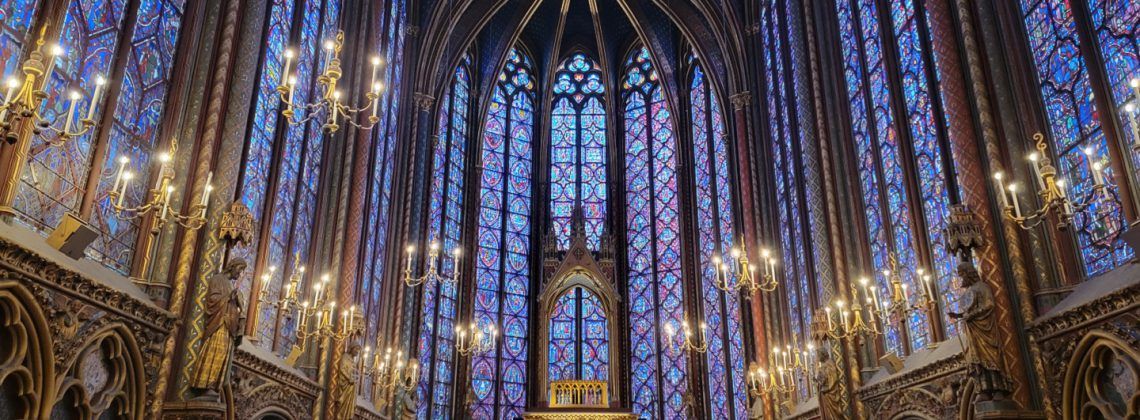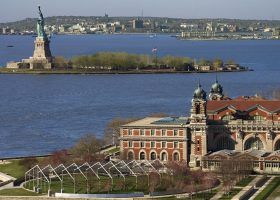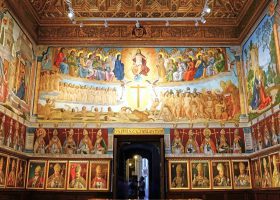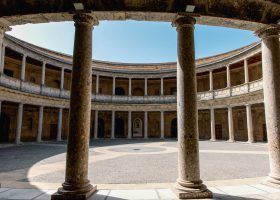The show-stopping stained glass windows of Sainte-Chapelle will no doubt capture your attention and imagination. However, there are essential things to see inside and outside of this Parisian treasure house of color and light! We’ve selected the most significant things to see at Sainte-Chapelle in preparation for your visit!
Pro Tip: Planning what to do on your trip to Paris? Bookmark this post in your browser so you can easily find it when you’re in the city. Check out our guide to Paris for more planning resources, our top Paris tours for a memorable trip, and how to see Paris in a day.
The 7 Most Important Things You Have To See at Sainte-Chapelle
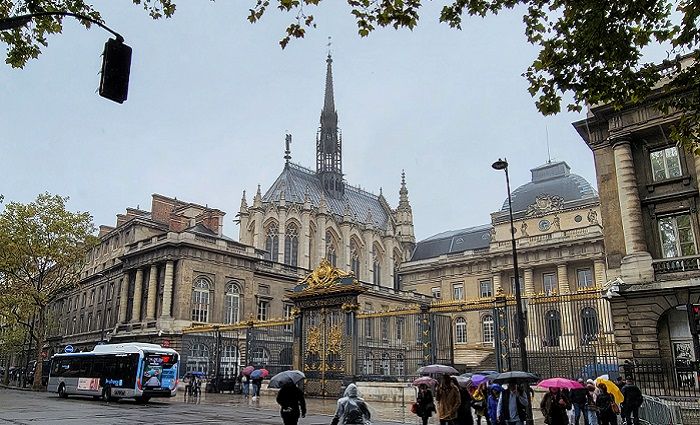
Visitors of Paris and even lifelong inhabitants of the city might easily pass Sainte-Chapelle without ever realizing it was there. That’s because the builders tucked it away in the high-security embrace of the Palais de la Cité or City Palace.
Former kings of France used the palace from the 6th to the 14th century. Many of them renovated and rebuilt it extensively through the centuries, as was common for any notable building. Nowadays, it is the heart of the French justice system. It houses two major legal courts as well as the royal chapel.
Like all Gothic churches, that architects of Saint-Chapelle (Holy Chapel) intended for it to resemble a heavenly space. The soaring walls, lofty ceilings, and external flying buttresses of a typical Gothic cathedral are just half the story though. The stained glass windows are the stars of this show—their colors make up celestial bouquets offered to God.
Things to Know About Visiting Sainte-Chapelle:
Before we get to the things you should see here at Sainte-Chapelle, let’s also talk a bit about your visit. The chapel is on the premises of the legal courts. It is also a national treasure, so security is fairly stringent. You will have to pass through a metal detector to enter. Polite security guards will scan and search your bag. Afterwards, you will exit into the courtyard to the ticket office and entrance.
If you are unable to climb the narrow, winding, medieval staircase that takes you from the lower chapel to the upper chapel, an elevator in an adjacent building is available. You will require an escort to access the elevator, so be sure to make a reservation in advance.
Not ready to book a tour? Check out our Paris Guide for more resources.
Sainte-Chapelle’s Royal Origins
In 1200, Philippe Auguste modernized of the Palais de la Cité complex. In his fascinating book, “Paris: The Secret History”, Andrew Hussey tells how Phillipe Auguste established the imposing Palais de la Cité as the royal seat of power and his grandson, Louis IX, expanded it further. Better known as “Saint Louis,” he hired an architect to design an exquisite royal chapel to house several holy relics.
Sainte-Chapelle and the notorious Bonbec Tower around the corner in the Conciergerie are all that remain of Philippe Auguste’s original palace. Hussey also notes that the original tower served as the main torture chamber of the palace’s justice center during the Middle Ages. According to rumors, a prisoner would “sing like a bird” after being tortured there. In French, bon bec means “wide-open beak”. Hence, the name: Bonbec Tower.
Beyond the confines of the Palais de la Cité are several noteworthy, historic structures. Notre-Dame de Paris, the famous cathedral, is just a five-minute walk away. The Hôtel-Dieu, a hospital dating to the 7th century, also shares the square with Notre-Dame. These three places are important sites on the Île de la Cité or City Island in the middle of Paris’ iconic Seine River. It’s only about five streets wide and 10 streets long, but it is bursting with history.
The overall design of Sainte-Chapelle is quite elaborate, especially in comparison to the nearby Notre-Dame of Paris. Architects designed Notre-Dame (Our Lady) in the early Gothic style and began construction in 1163. In contrast, Louis XI ordered construction of Sainte-Chapelle sometime after 1238, according to Sainte-Chapelle expert, Alain Erlan-Brandenburg. This more embellished style emphasizes light and lightness, and is appropriately name the Rayonnant Gothic style which means “radiant”.
7. The Steeple

Your first glimpse of the chapel from the street will be of the rear, semi-circular portion called the apse. Architectural historian, Jeanne Halgren Kilde explains that the altar is always located in the apse where all of the most sacred activity takes place. In fact, most churches keep and frequently display their holy relics in the apse.
Stroll along the south side of the building toward the western façade. There are an infinite number of things to look at on the exterior of Sainte-Chapelle. Look up past the extravagant buttresses and the glowering gargoyles at the steeple, which starts at 108 feet high, according to Sainte-Chapelle expert, Robert Branner. Believe it or not, it is the fifth steeple to rise above the royal chapel since it was first built.
Architectural historians aren’t sure what the first steeple looked like. However, the second steeple was built during the reign of Charles V, and new steeples continued to replace those that were burned or otherwise destroyed.
According to historian Helen Henderson, the present one was erected in 1853, and it is regarded as an ingenious technical feat. A Parisian carpenter named Bellu constructed it with cedar wood, while other carpenters made the wood carvings on the steeple and the angel in the apse.
6. The Western Façade
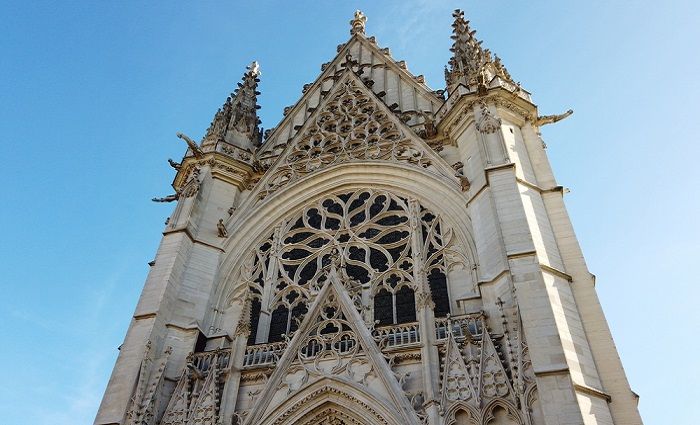
After going through security, but before going to the ticket counter, walk around to the far end of the structure. It’s on the opposite end from the apse. There you’ll see an impressive, two-storied porch. Linger there for a while and admire the entrance to one of the world’s most exquisite examples of sacred architecture.
Among the sculptural decorations on the façade you’ll see the fleur-de-lis or lily flower. This stylized representation of a lily has important symbolic connotations, specifically, the representation of the Virgin Mary. It’s also been the insignia for French royalty since the reign of King Clovis I in the 5th century! Sainte-Chapelle expert Meredith Cohen notes that you can also see representations of the crown of thorns, the first holy relic that Louis XI brought to Saint-Chapelle.
Some of the main characteristics of Gothic architecture such as pointed arches and intricate, stone carving are also apparent. Even the roof of the portal or entrance is gracefully pointed! The famous rose window—the enormous circular stained glass creation—is a quintessential Gothic-style element.
There’s also a reason for a western entrance rather than the more obvious eastern side. Halgren Kilde explains that Christian churches traditionally have west-facing main entrances with altars on the east side. The reason? It’s believed that Christ’s second coming would be from the east. The effect of the sun as it crosses the sky from east to west is dazzling and inspirational.
5. The Lower Chapel
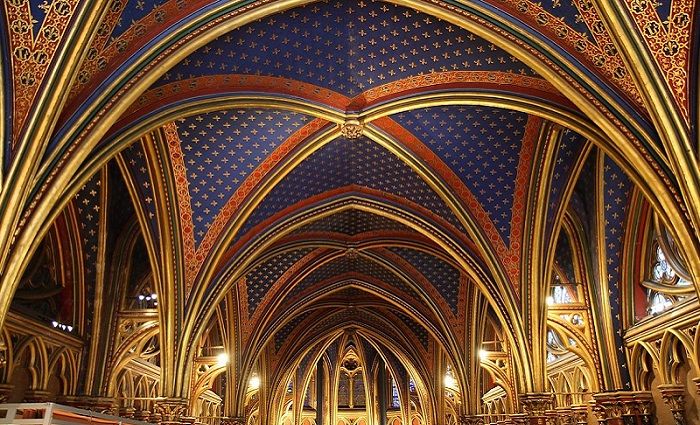
The intimate feeling of the Lower Chapel, dedicated to the Virgin Mary, may surprise you. Cohen notes that the ceiling is only 21 feet high. The side aisles are 7 feet wide and the central area, the nave, is just 20 feet wide. The small gift shop on the left as you enter is definitely worth visiting on your way out.
You’ll notice that there are small flying buttresses on the inside of the building. What, you may wonder, does a flying buttress do? These rib-like structures are one of the signature features of a Gothic structure. They extend the downward force of masonry from walls and ceilings outward. That means that you can build taller walls and higher ceilings. You can also open those walls up to massive windows!
The ceilings in the Lower Chapel don’t soar to heavenly heights. Instead, they feel protective, private, and resemble a night sky studded with stars. On closer inspection, you’ll realize those stars are fleurs-de-lis!
You’ll also see stained glass windows in this section of Sainte-Chapelle that date back to the 19th century. They all represent scenes from the life of the Virgin Mary.
During the French Revolution, many of the churches in Paris bore the brunt of anti-church and anti-monarchy sentiment. Rioters destroyed important elements of Sainte-Chapelle such as statues and windows. In fact, Erlan-Brandenburg notes that during the chaotic period after the revolution, grain was even stored in the chapel!
4. The Upper Chapel
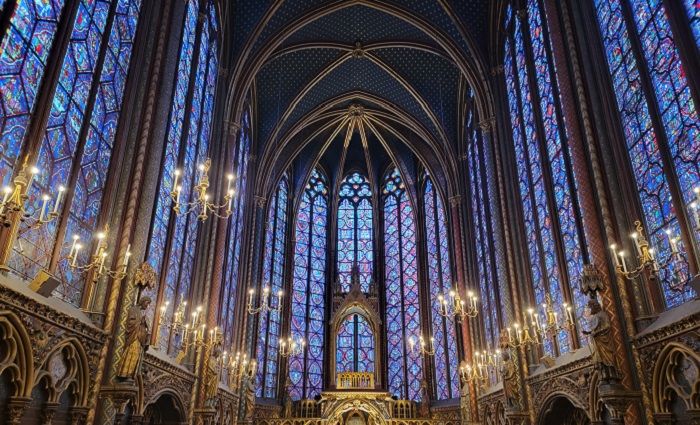
The beauty of the Lower Chapel may prepare you for the incomparably magnificent Upper Chapel. This portion of Sainte-Chapelle was dedicated to the Holy Cross, according to Branner. Our best advice is to take a deep breath before climbing the corkscrew staircase and take your time. Once you do reach the top, you’ll feel as though you’ve entered heaven itself!
The stained glass stuns most visitors into quiet reverence as they step into the room. We promise that you’ve never seen anything like it! French architectural historian, Sylvie Clavel, notes that there is 6,458 square feet of glass in those windows—not including the rose window.
Ornate pillars cleverly support the elegant, ribbed vaulting. However, buttresses do most of the heavy lifting on the exterior. The result is that this interior space can be as open and airy as possible.
The Upper Chapel is 34 feet wide and 108 feet long, writes Erlan-Brandenburg, but it seems much larger. That’s due to the soaring ceiling and the walls which are mostly made up of glass. The windows seem to open into another world, a heavenly place. More about those later.
Not ready to book a tour? Check out our Paris Guide for more resources.
3. The Sacred Relics
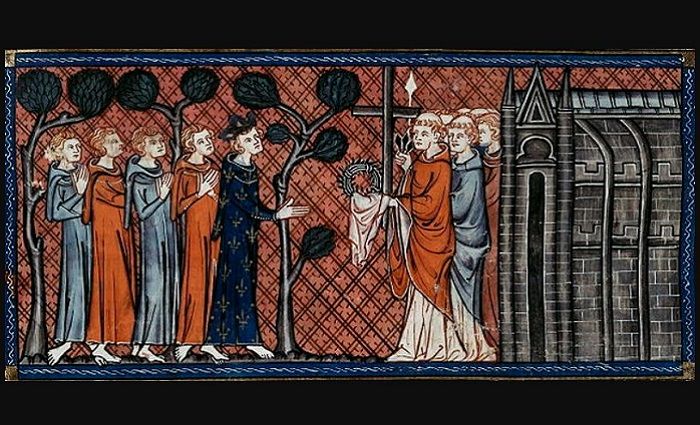
Sainte-Chapelle is a sacred shrine that originally housed no less than 22 holy relics. Hussey tells us that Louis IX purchased the crown of thorns from the Emperor of Constantinople in 1239. A shrewd negotiator, Baldwin II had pawned the so-called “Passion relics” to a bank in Venice. Louis IX, Baldwin’s cousin, essentially rescued the relic and brought it to Paris with the hope of turning Paris into the “New Jerusalem”.
Two years later, he acquired a fragment of the true cross and the lance used to pierce the side of Christ. According to historian Robert Branner, the relics cost three times more than the entire cost of constructing Sainte-Chapelle! They were kept in an ornate chest made of silver.
After their arrival, Parisians could visit Sainte-Chapelle to view the relics on Good Friday. Today, none of them remain at Saint-Chapelle. Instead, they are now held in the treasury in Notre-Dame. Still, the altar and original shrine of these relics is a worthy thing to see at Sainte-Chapelle.
2. The Sculpture and Painting in the Upper Chapel and Apse
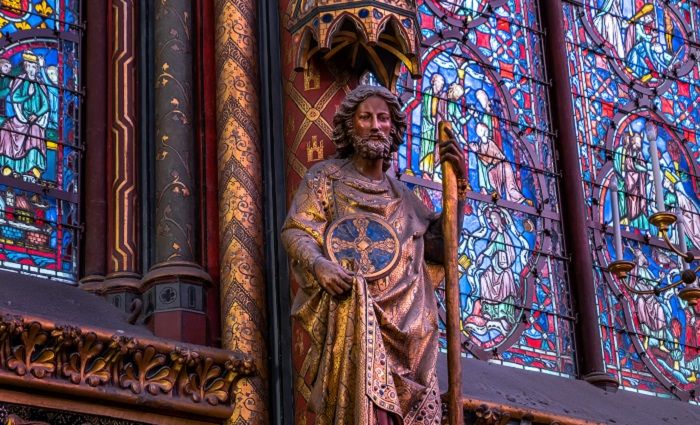
As far as decoration goes, stained glass dominates the Upper Chapel. There is a lot more to see, however! In his book, “Art and Crusade in the Age of Saint Louis”, art historian Daniel Weiss takes a thorough look at the decoration of Sainte-Chapelle and the different messages it communicates.
A mural of Christ in majesty surrounded by adoring angels adorns the space beneath the rose window. Weiss reveals that such paintings can have multiple meanings. For example, the mural is about the triumph of Christ but also the power of Louis IX.
Beneath the band that divides the windows from the lower walls, you’ll see a series of bays along both aisles. Within the four-sided medallions beneath the arches, artists painted scenes from the Old Testament. One scene depicts Abel offering a lamb to God. In another, Abraham prepares to sacrifice his son, Isaac. See what else you can find!
In the apse, an elaborately decorated canopy crowns the reliquary platform. The ornate canopy includes carvings of angels holding a crown of thorns. Above the middle band of the wall, there are 12 life-size, stone statues depicting the 12 apostles. According to Weiss, these companions of Christ were intended to stand guard over the sacred relics. Six of them are replicas. You can see the originals in the Cluny Museum, which is the National Museum of the Middle Ages in Paris.
At some point, the six “missing” statues acquired the nickname, “the unlucky apostles”. They’d been removed forcefully from Sainte-Chapelle during the Revolution. Hooligans beheaded four of the figures. Fortunately, a pious elderly woman who witnessed the act, took them and hid them or they’d have been lost forever! Ultimately, the stolen sculptures somehow found their way to the basement of the Louvre Museum!
1. The Stained Glass Windows and Rose Window
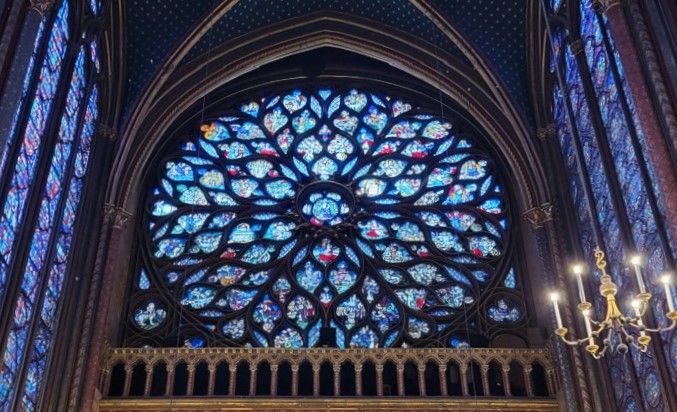
No one leaves the Upper Chapel unchanged. The effect of the colored light is transformative. Standing in the midst of the light as the sun moves slowly across the sky is a spiritual experience. The scenes featured in the windows from both the Old and New Testaments depict nearly 1,200 biblical figures, according to Meredith Cohen. Despite damage over the years, two thirds of the windows in Sainte-Chapelle are original!
The predominant colors of the stained glass are blue and red, although you’ll see other colors as well. Medieval stained glass artists often rendered scenes in grisaille or gray. Throughout the imagery, black outlines make the images more visible. The scenes have ornamental background in which you may see fleurs de lis, towers, and crowns.
Medieval stained glass windows tell their stories from bottom to top, and there are two distinct storylines in the stained glass. The first is the story of the Jewish people from Genesis to the book of Revelations. The second is the childhood and Passion of Christ. Take time to explore these windows and identify as many stories as you can.
Finally, the stunning rose window was installed in the late 15th century. The rose, with its 87 petals, illustrates the New Testament book of Revelations. In its center, Christ returns in glory, holding a sword in his teeth.
Overall, Cohen emphasizes, the King’s designers of these windows intended for them to glorify the sacred relics. Louis IX, who can be seen wearing the crown of thorns, is also given his due!
Not ready to book a tour? Check out our best Paris tours to take and why.
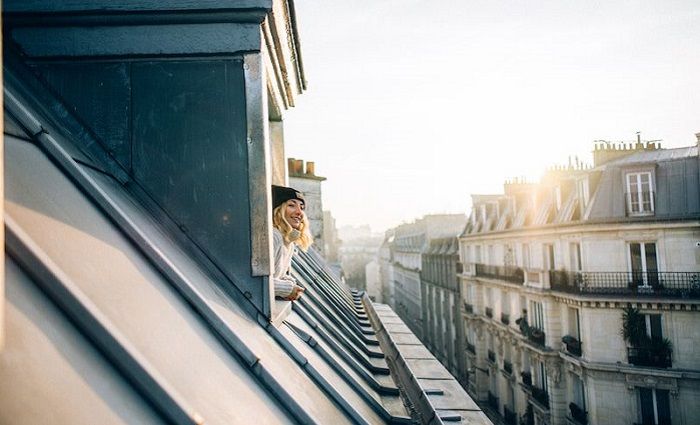
Where To Stay in Paris
With a city as magnificent as Paris, it can be hard to find the perfect hotel at the perfect price. Explore the best hotels and places to stay in these incredible neighborhoods in Paris.
